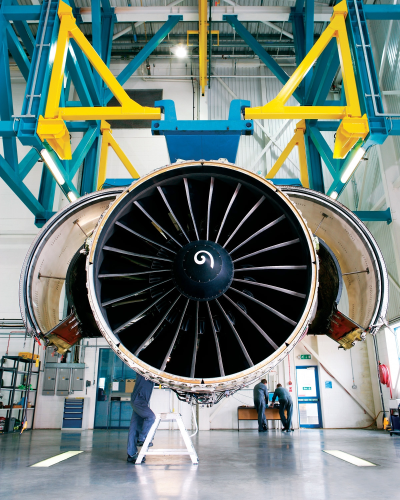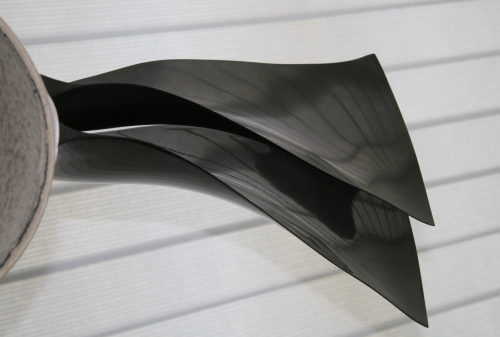

Airlines today are parking perfectly serviceable aircraft in deserts and acquiring instead current-generation successors which, largely thanks to composites, are lighter and use less fuel. This shows the extent to which aircraft operators are prepared to invest in weight saving and explains their desire for new types such as the Boeing B787 Dreamliner and Airbus A350 XWB in which reinforced plastics account for about half the aircraft’s structure by weight. (See Growing demand for eco-efficient aircraft.)
Reinforced Plastics readers will be well aware of composites’ primacy in aircraft interiors and their growing contribution to secondary and primary airframe structures, but will perhaps be less cognisant of the effect they are now having on aero engines.
| While the main ’guts’ of an engine are generally too hot for composites, the cool running front end – principally the large fan and its containment case – is a prime prospect for composites application. |
The fan on a modern jet engine drives most of the air entering the air intake round the outside of the jet core and out of the back of the nacelle, in doing so accounting for 70-90% of the engine’s total thrust. The remaining percentage is due to the core, the true jet portion of the engine. This latter also powers the fan which can be likened to a large propeller, albeit with a greater number of blades and revolving at higher speed. In the latest turbofan engines, up to 12 times more air is driven round the engine core than passes through the core itself, the actual proportion being referred to as the by-pass ratio.
Traditionally, fan blades have been made from metal, usually titanium, but aero engine manufacturers can now save substantial weight by substituting composites. Similarly, the containment case, there to contain the results of any blade separation and prevent high-speed debris from impacting the airframe or aircraft systems, can now be composite rather than metal or a metal-composite hybrid (typically aluminium over-wrapped with aramid).
Weight saved in the fan/containment case pairing has a knock-on effect, enabling components such as shafts and bearings, the pylons which attach the engine to the wing and the associated wing structure to be made lighter also. In aggregate, half a ton or more can be saved per engine, a prize well worth having given the high price of aviation fuel today.
Composites are also more durable, notably having greater tolerance to fatigue than metal, and can be moulded into shapes that are nearer to the three-dimensional aerodynamic ideal. They also resist creep, the outward expansion that can occur in metal blades due to centrifugal force generated at revolution rates of around 2500 rpm (typical fan rate in cruise), meaning that the clearance engineered initially between the blade tips and the surrounding duct has to be greater than it should be for optimum engine performance.
Pioneer
Although Rolls-Royce was a notable pioneer of composite fan blades (more of this in Part 2), the first company to successfully introduce a commercial jet engine having such blades was American engine maker GE. Its initial GE90 engine, which first entered service on British Airways Boeing B777 long-range widebody twinjets in 1995, has a by-pass ratio of 8.4 and a 10 ft diameter fan having 22 wide-chord fan blades that are moulded in a toughened epoxy resin reinforced with high-grade carbon fibre. A polyurethane surface coating reduces wear on the blade while a titanium leading edge provides protection against strikes from birds, ice chunks and other ‘foreign objects‘. This titanium guard, which also provides the required sharp leading edge that is difficult to engineer in composite, is replaceable and can be re-blended.
GE, which boasts 25 years of prior development in composite blades dating back to original NASA-funded programmes, says that its GE90 blades have withstood a battery of aggressive tests including the critical chicken-gun test in which bird carcases are fired into running engines to simulate bird strike events occurring at flying speeds. Positive test results have been buttressed by results from dozens of actual ingestions on aircraft in service of birds as large as herons and multiple Canada geese, in which no significant fan damage occurred. Laminated blade specimens exposed to aircraft fluids (fuel, hydraulic oil etc) maintained, says GE, 95% of their base properties. Service experience shows that moisture uptake and material fatigue are minimal. Blade-off tests in which blades are explosively sheared so that they are flung outwards by centrifugal force, have proved the efficacy of composite containment cases.
A growth version of the GE90, the GE90-115B, is currently the world’s most powerful turbofan engine, an example having delivered nearly 128,000 lb of thrust on a test rig (although the engine is rated at 115,000 lb). A smaller engine, the GENx, has been developed for medium-capacity long-range aircraft including the new B787, Boeing’s latest and most fuel-efficient passenger jet, now in early revenue service. Use of a 111 inch diameter 18-blade composite fan, derived from the GE90 technology, has enabled weight of the B787 twinjet to be reduced by 700 lb per aircraft compared with what could be achieved with metal-fanned engines. (See Boeing 787 completes first flight with GE engines.)
Manufacture
Blades are produced by CFAN, a joint venture between GE and French engine specialist Snecma, at a dedicated composite component facility in San Marcos, Texas, USA. This factory has so far produced more than 20,000 composite blades, initially for the GE90-115B and, for the last few years, for GENx engines as well. A rigorous manufacturing process results, says the company, in blades that are free of voids, wrinkles and other defects.
| GE90 blades are made using preforms that comprise hundreds of plies of unidirectional carbon prepreg tape and fabric near the blade root, where thickness is up to 4 inches, thinning out progressively to about 0.25 inches at the tip. |
GE90 blades are made using preforms that comprise hundreds of plies of unidirectional carbon prepreg tape and fabric near the blade root, where thickness is up to 4 inches, thinning out progressively to about 0.25 inches at the tip. Plies are cut ultrasonically, each ply shape having previously been computer generated.
Plies are then laid up using a laser projection system. The resulting preform is placed in a mould and resin is injected. Cure takes place in an autoclave at some 150°C, with consolidation pressure also being applied. Resulting near-net shape parts are milled to final dimensions in 5-axis CNC machining centres.
The fan containment case developed for the GENx is manufactured by GKN Aerospace Services at its aerostructures facility in Alabama. It comprises a combination of biaxial and triaxial carbon/epoxy braids woven against a fan casing tool. A triple layer of triaxials laid mutually at 60° makes the weave thicker in the critical centre section of the sleeve than towards its ends. This all-composite construction is claimed to be superior to the Kevlar (aramid)/aluminium containment system widely used in other engines, with its tendency for moisture to collect and cause corrosion at the interface between the two materials.
GKN Aerospace Services also manufactures the single-piece acoustic liner that substantially reduces fan noise. The liner comprises glass fibre/epoxy skins sandwiching a Nomex aramid honeycomb core.
At this year’s Farnborough Air Show, GE Aviation said it is working on fourth-generation composite blades for the planned GE9X engine intended for new Boeing B777 models, dubbed B777X. The company is also investigating the potential for saving more weight by combining the fan containment case with the air inlet in a single integrated unit. ♦
Part 2 of this feature is available here.
This article was also published in the November/December 2012 issue of Reinforced Plastics magazine.





